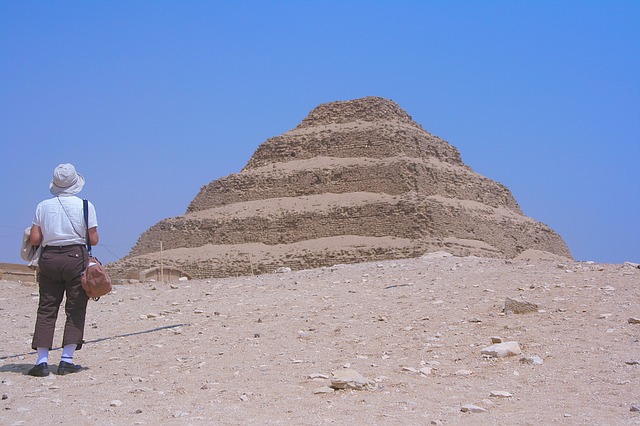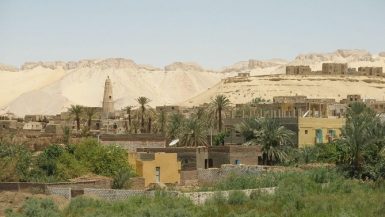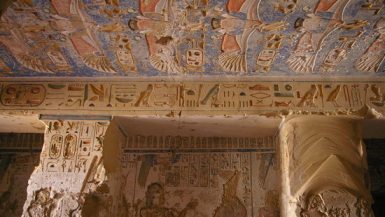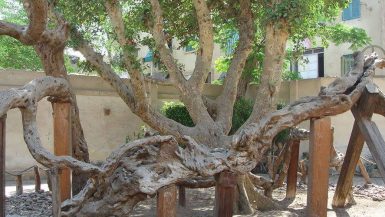Saqqara | Ankh |
Saqqara is located south of modern Cairo, on the west bank of the Nile river, and covers an area over 6 km long and more than 1.5 km wide.
It was once part of a larger system of cemeteries that spanned the modern sites of Giza, Abusir, and Dahshur. The area was first used as a necropolis during the 1st Dynasty, and continued to be used for burials for the next 3,000 years.
This site also became a center for ‘animal cults’ from the Late Period (ca. 712 – 343 BC) onward, and ibises, falcons, baboons, cats, dogs, and bulls were interred here in special cemeteries.
Saqqara
Upon arrival at the site, the visitor is invited to explore the new Imhotep Museum and view a short introductory film produced by National Geographic.
Leading up towards the escarpment are the Bubastieion cliffs; here can be found a series of New Kingdom tombs (ca. 1550 – 1070 BC) currently under excavation by Dr. Alain Zivie. The remains of a temple precinct dedicated to the goddess Bastet are buried below what is now a parking lot on the top of these cliffs.
On the plateau beyond, emerging majestically from the sands, is the impressive Step Pyramid of Djoser, first king of the 3rd Dynasty (ca. 2630 – 2611 BC). This was the first pyramid, and the first stone monument, in the world.
Saqqara Pyramid
To the northwest is the Unas Pyramid Complex, built during the 5th Dynasty (ca. 2353 – 2323 BC).
Saqqara pyramid itself is closed, but the mortuary temple to the east is easily accessible. The causeway leads down to an ancient lake that once formed a harbor for the king’s valley temple.
Westwards, alongside Unas’s causeway, can be found a number of private tombs from the Old Kingdom, including those of Ptahhotep, Iy-Nefret, and Niankhkhnum and Khnumhotep.
Saqqara Facts
To the east of these tombs is the Pyramid of Teti, first king of the 6th Dynasty (ca. 2323 – 2291 BC), in which are inscribed Pyramid Texts. These spells were designed to ensure the survival of the monarch in his afterlife and his transformation into a divine state.
Nearby are the private tombs of Mereruka, Kagemni, Unas-ankh, and Iruka-ptah. Northwest of the Step Pyramid are the Mastaba of Ti and the Serapeum, cult center for the Apis bulls.
The pyramids of Djedkare-Isesi, Pepi I and II, Merenre, and the Mastaba Faroun of Shepseskaf, lie at South Saqqara, which is not open to the public
Location and Directions
Saqqara region, 30 km south of Cairo
BY BUS: Take bus # 330 from Midan Giza to the Saqqara village.
BY MINIBUS: Take a bus or taxi to Pyramids Road, get off at Maryotteya Canal, and head down to the canal, where there are many minibuses that go on to Saqqara.
BY TAXI: Ask for “sa-a-ra”. Be clear if you only want to go to Saqqara, because some drivers will assume that you want to include Memphis and Dahshur.
HOURS OF OPERATION:
Open daily.
1 May – Ramadan: 7:00 AM – 7:00 PM
1 Ramadan – 30 April: 8:00 AM – 5:00 PM
Ticket Cost
General Admission:
Egyptian: 10 LE
Egyptian Student: 5 LE
Foreign: 100 LE
Foreign Student: 50 LE
Student rates available to bearers of a valid student ID from an Egyptian university or an International Student ID Card
Includes admission to the area and to the following monuments:
Imhotep Museum
Djoser Pyramid Enclosure
Pyramid of Teti (Interior)
Tomb of Mereruka
Tomb of Kagemni
Mastaba of Ti
Tomb of Iy-Nefert
Tomb of Ptahhotep
Tomb of Unas-ankh
Egyptian: 10 LE
Egyptian Student: 5 LE
Foreign: 100 LE
Foreign Student: 50 LE
Extra Admission:
Tomb of Iruka-ptah
Tomb of Niankhkhnum & Khnumhotep
Horemheb cemetery
Saqqara Facilities
Cafeteria, Gift Shop under construction at museum.
NO PHOTOGRAPHY ALLOWED INSIDE THE TOMBS.
Saqqara is not wheelchair accessible.






Leave a reply